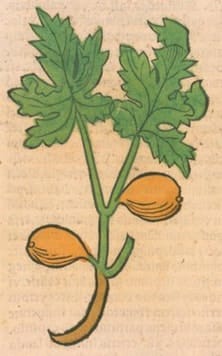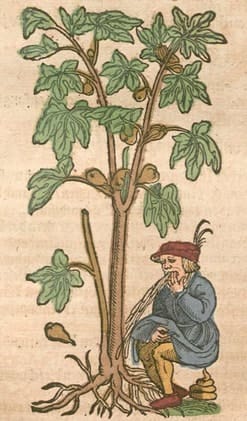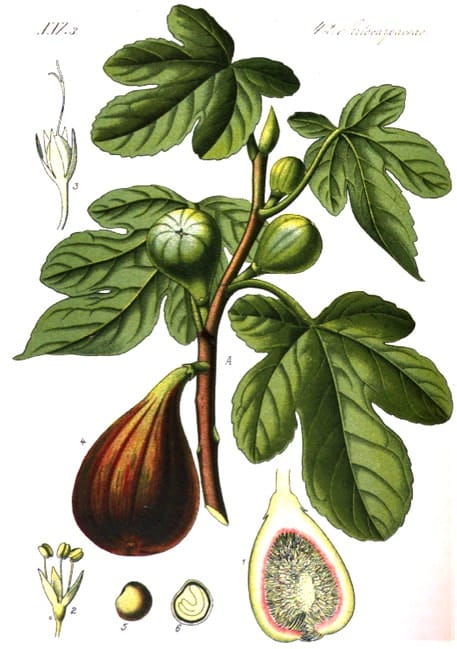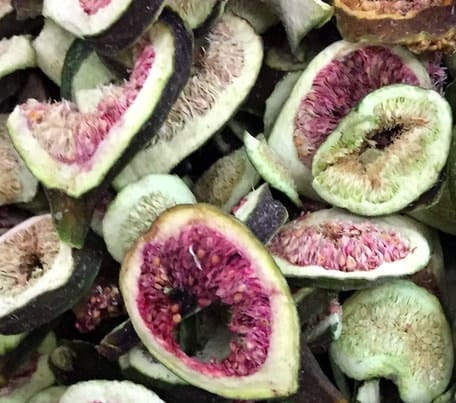Ficus, Fig tree
Dried Figs were traditionally called CariceAnjeer (Unani)
 Ortus Sanitatis, Meydenbach, 1491
Ortus Sanitatis, Meydenbach, 1491 Krauterbuch, Lonitzer, 1578
Krauterbuch, Lonitzer, 1578 Flora von Deutschland, Kohler, 1886
Flora von Deutschland, Kohler, 1886 Dried Fig slices added to flower teas in China (Adam, 2017)
Dried Fig slices added to flower teas in China (Adam, 2017) Members CLICK HERE for the PRO VERSION
Members CLICK HERE for the PRO VERSIONBotanical name:
Ficus carica
Related species are used similarly in various systems.
Parts used:
Fruit, most commonly in their dried form
Temperature & Taste:
Dried Figs: Warm, moist; Fresh Figs and Temperate and Moist. Sweet
Classification:
PURIFYING LENITIVE SUPPURATIVE RAREFYING. RESOLVENT
APHRODISIAC EXPECTORANT STRENGTHENING. ALEXIPHARMIC ANTI-TUSSIVE
PECTORAL
Uses:
1. Strengthens the Lungs, Stops Cough:
-Hoarseness, Cough, Whooping Cough, Asthma, shortness of Breath, Lung Ulcers, Hemoptysis
-cleanses tough phlegm from the Lungs
-useful in Lung deficiency
2. Clears Heat, Laxative:
-habitual constipation, Diverticulitis, Enteritis, Dysentery, Hemorrhoids
3. Nourishes Qi and Blood:
-Convalescence, chronic Illness, chronic Debility, diseases of the Elderly
-nourish the Blood, increase body weight
-nourish Seed, promote Lust (Reginum Sanitatis Salerni, 1528)
4. Clears Heat and Poison:
-protects from infection of Epidemic diseases
-Measles, Pox
-Tumors, Cancer
5. Promotes Urine, clears Stones:
-Edema, Gravel, Stones (Urinary and Gall Bladder)
6. Moves the Blood:
-gently promote Menstruation
-has been used for bruising, trauma
-‘Eaten by women near the time of Birth to hasten it’ (Marrow of Chirurgery, Cook, 1685).
7. Externally:
-they soften, ripen and dissolve Swellings; the roasted or decocted fruit was split and applied to Tumors.
-milky juice of the Fig tree is applied to Warts, Freckles, ‘lichen-like eruptions’, and Leprosy (since Dioscorides)
-milky juice is dropped into teeth for Toothache.
-juice is dropped into the ears for Noise, Pain and Deafness.
-leaves are made into a wash for Sore Heads, Morphew, Scabs, White Scurf, Running Sores and Leprosy.
-a wash can be dropped into old Ulcers to cleanse the excess moisture and promote the growth of new flesh.
-One old TCM authority said ‘the leaves of the plant is the best herb for Hemorrhoids’.
-roasted fruit was split and applied to Dental Abscesses; used as a wash for Gum Boils.
-ashes of the wood is made into an ointment for Chilblains.
-juice was also applied to poison Bites.
-Green fruit has been applied to Gout in TCM.
-in TCM, it is mixed with oil and applied to various infections such as Carbuncles, Cellulitis, Scabies, ulcerated Small Pox and Breast Masses
Dose:
Dry Figs: 3–6 in Decoction
Correctives:
… available in PRO version
Substitute:
… available in PRO version

Main Combinations:
1. Cough, Asthma:
i. Figs with … available in PRO version
ii. Figs with … available in PRO version
ii. Figs with … available in PRO version
iii. Figs with … available in PRO version
iv. Figs with … available in PRO version
v. with Lung deficiency, Figs with … available in PRO version
vi. Asthma from crass Humors, Figs with … available in PRO version
vii. Asthma, Figs with … available in PRO version
2. Laxative:
i. Figs with … available in PRO version
ii. Figs with … available in PRO version
iii. for use in Hemorrhoids, Figs with … available in PRO version
3. To resist Infection in Epidemics, Figs with … available in PRO version
4. To promote the eruption of Measles and Small Pox, Figs with … available in PRO version
5. As an Aphrodisiac, Figs with … available in PRO version
6. Scrofula, Tumors, Figs beaten with … available in PRO version
7. As a gargle for inflammations of the Throat, macerate Figs, … available in PRO version
8. Decoct Figs with … available in PRO version
9. Edema, decoct Figs with … available in PRO version
10. Burn Figs … available in PRO version
11. Grind raw Figs … available in PRO version
12. Milky juice of the Fig mixed with … available in PRO version
Major Formulas
Decoction of Fruit
Decoction of Fruit and Flowers
Decoction to Strengthen the Lungs
Decoction of Hyssop (Zacharia)
Decoction of Hyssop and Coltsfoot (Wirtzung)
Decoction of Hyssop and Rue
Decoction for Asthma (Zacharia)
Decoction for Asthma from Crass Humors (Hamech)
Electuary of Nuts (Mithridate)
Cautions:
1. They should not be taken in excess
2. ‘being too frequently used they occasion Flatulencies, hurt the Liver and Spleen, and render the Flesh lax, turgid, and flabby. Persons who are liable to Obſtructions of the Bowels, or whose Belly is over moiſt, ought to avoid using them’. (A Treatise on Foreign Drugs, Geoffroy and Thicknesse, 1749)
3. ‘They ferment and rarify the Bile like Honey, Sugar, and other sweet Things; and are therefore very improper in bilious Temperaments, in Fevers arising from Bile, and inflammations of the Spleen and Liver’. (A Treatise on Foreign Drugs, Geoffroy and Thicknesse, 1749)
Main Preparations used:
Pulp
-
Extra Info
-
History
|
‘Figs were a valued article of food among the ancient Hebrews and Greeks, as they are to the present day in the warmer countries bordering the Mediterranean. In the time of Pliny many varieties were in cultivation The Latin word Carica was first used to designate the dried fig of Caria, a strip of country in Asia Minor opposite Rhodes, an esteemed variety of the fruit corresponding to the Smyrna fig of modern times. In a diploma granted by Chilperic II., king of the Franks, to the monastery of Corbie, A.D. 716, mention is made of “Karigas” in connection with dates, almonds and olives by which we think dried figs |
(Caricce) were intended. Dried figs were a regular article of trade during the middle ages, from the southern to the northern parts of Europe. In 1380 the citizens of Bruges, in regulating the duties which the “Lombards,” i.e. Italians, had to pay for their imports, quoted also figs from Cyprus and from Marbella, a place south-west of Malaga. In England the average price between A.D. 1264 and 1398 was about 1 3/4d. per lb., raisins and currants being 2 3/4d.’ (Pharmacographia, Fluckiger & Hanbury, 1879) |
